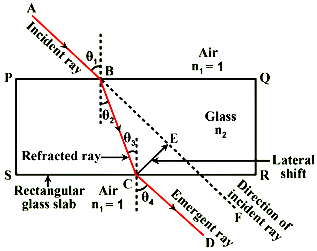When ray of light incident on the parallel side of the glass slab the emergent ray shifts laterally to some distance that distance is called the lateral shift.

Consider a rectangular glass slab PQRS having parallel faces PQ and RS as shown in the figure. A ray of light AB in the air is incident on the glass surface PQ. As the ray AB enters from the air(rarer medium) to glass (denser medium), the ray bends towards the normal and follows the path BC inside the glass slab. At point C, refraction takes place again. As the ray BC goes out from glass(denser medium) to air (rarer medium), the ray bends away from the normal and follows the path CD outside the glass slab. Here, the ray AB is called the incident ray, BC the refracted ray and CD the emergent ray.
Let n1 and n3 be the refractive index of air and n2 the refractive index of glass.
On applying smells law at the surface PQ,
n1sinθ1 = n2sinθ2
For air medium, n1 = 1
∴ sinθ1 = n2sinθ2 ......(1)
On applying snells law at the surface RS,
n2sinθ3 = n3sinθ4
For air medium n3 = 1
n2sinθ3 = sinθ4 ......(2)
As θ3 and θ2 are alternate angles, we have θ3 = θ2
Therefore (2) becomes:
n2sinθ2 = sinθ4 .......(3)
Comparing (1) and (3) we get:
sinθ1 = sinθ4
∴ θ1 = θ4
i.e., angle of incidence = angle of emergence
The emergency ray CD is parallel to the incident ray ABEF. However, the emergent ray is linearly displaced by a perpendicular distance CE because of refraction. When a ray of light is refracted from two refracting surfaces, the emergent ray is displaced from the direction of the incident ray. This displacement of the emergent ray from the path of the incident ray is called lateral shift.
Lateral shift depends on
i. The perpendicular distance between the two parallel refracting surfaces.
ii. The angle of incidence.
iii. Refractive index of the medium.